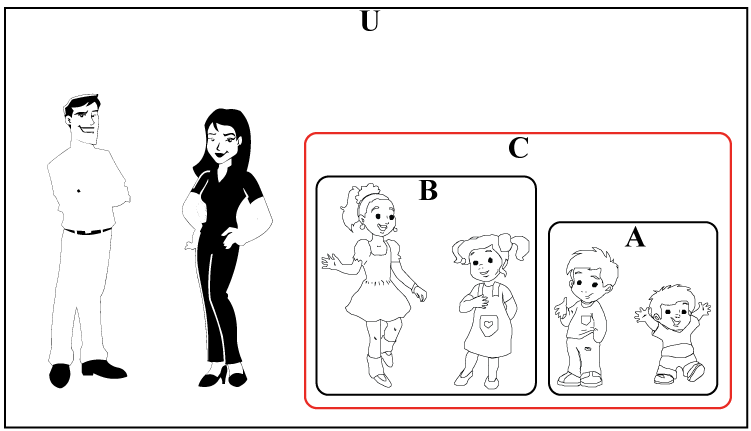Set Theory Concepts
∙ Introduction
∙ Definitions
∙ Universe & Subsets
∙ More on subsets
∙ Operations on sets
∙ Properties of operations
∙ Set graphs & Line graphs
Operations on sets
Like arithmetic operations, there are also operations on sets. They help us highlight the association among sets. The three basic operations are:
- union among sets
- intersection among sets
- difference among sets
Before discussing the operations, let us consider another form of depicting a set. In particular, depiction of association among sets. They are called Venn's diagram. Its application will be demonstrated along with discussion of the operation (below).
Union among sets
Given three sets A, B and C, if any elements picked from either A or B are also elements of set C, then we say that C is the union of A and B.
 For example:
For example:
U : universe composes of family members
A : set of boys (children)
B : set of girls (children)
C : set of children
Then,
set of children, C is the union of A and B.
Mathematically, C = A ∪ B (Venn's diagram on the right)
Notice that the number of elements in C (4) is the sum of number of boys (2) and girls (2), i.e., 4 = 2 + 2. However, operation of union is not the same as arithmetic addition. This is demonstrated below.
 If,
If,
D : set of females
E : set of mother and children
Then,
set of mother and children, E is the union of C and D.
Thus, E = C ∪ D
Observe that the number of elements in E, 5 ≠ 3 + 4.
Intersection among sets
Given three sets A, B and C, if any elements picked from in-common elements of A and B are also elements of set C, then we say that C is the intersection of A and B.
 For example:
For example:
set of girls, B is the intersection of C and D.
Mathematically, B = C ∩ D.
Difference among sets
Given three sets A, B and C, if any elements picked from A which is also not an element of B are elements of set C, then we say that C is the difference of B from A.
 For example:
For example:
set of boys, A is the difference of D from C
Mathematically, A = C - D.
Note that, set of mother = D - C.

